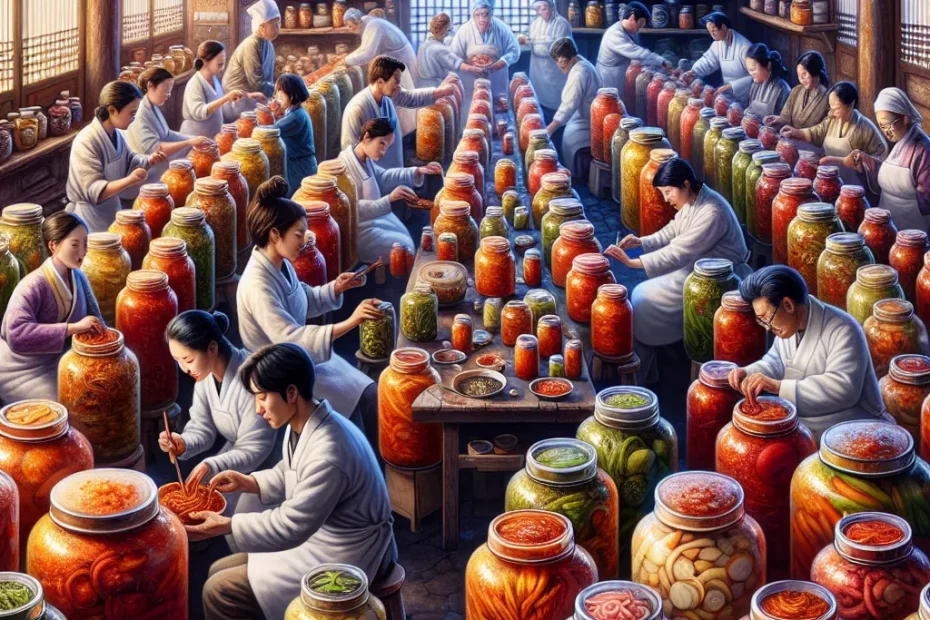Kimchi, Korea’s signature dish, holds a special place in Korean culture and cuisine. Originating centuries ago, this fermented vegetable dish has evolved into various regional varieties, each with its own unique flavors and ingredients. Known for its health benefits, kimchi is not only a delicious side dish but also a powerhouse of nutrients. Exploring the history, preparation methods, and regional differences of kimchi sheds light on the rich culinary heritage of Korea. Let’s delve into the world of kimchi and uncover the secrets behind this iconic Korean dish.

Origin and History
Kimchi, Korea’s signature dish, is a traditional fermented vegetable dish that has been a staple in Korean cuisine for centuries. The history of kimchi dates back to ancient times, with records of its consumption dating as far back as the Three Kingdoms period in Korea (57 BC – 668 AD). Originally, kimchi was a simple mixture of vegetables and salt, fermented underground in large earthenware jars to preserve vegetables for the long, harsh winters.
The Evolution of Kimchi
Over the years, kimchi has evolved into a diverse range of flavors and varieties, with each region in Korea developing its own unique recipes and methods of preparation. The most common type of kimchi is made with napa cabbage, radish, and a variety of seasonings such as red pepper flakes, garlic, ginger, and fish sauce. The fermentation process not only enhances the flavor of the vegetables but also creates beneficial probiotics that are known to promote gut health.
The Cultural Significance of Kimchi
The cultural significance of kimchi in Korea cannot be overstated. It is not just a side dish but a symbol of Korean identity and heritage. In fact, kimchi-making has been designated as an intangible cultural heritage by UNESCO, highlighting its importance in Korean society. Kimjang, the traditional process of making kimchi in large quantities to last through the winter, is a communal activity that brings families and communities together.
Kimchi’s Global Appeal
Today, kimchi has gained popularity worldwide, thanks to its unique flavor profile and health benefits. It is not uncommon to find kimchi in supermarkets and restaurants outside of Korea, showcasing its global appeal. Whether enjoyed on its own, as a side dish, or as an ingredient in various dishes like kimchi fried rice or kimchi stew, kimchi continues to captivate taste buds around the world.
In conclusion, kimchi’s rich history and cultural significance make it more than just a dish – it is a symbol of Korean tradition and a culinary delight that has stood the test of time. From its humble origins as a simple vegetable preservation method to its status as a global culinary sensation, kimchi truly embodies the essence of Korean cuisine and heritage. 🥢🌶️🇰🇷
Ingredients and Preparation
Kimchi, Korea’s signature dish, is a traditional fermented side dish made with various vegetables and seasonings. The main ingredient in kimchi is Napa cabbage, which is rich in vitamins A and C. Other key ingredients include Korean radish, garlic, ginger, and Korean red pepper flakes, known as gochugaru. These ingredients are mixed together with salt and fermented seafood like salted shrimp or fish sauce to create the unique flavor profile of kimchi.
Preparation Process
The preparation process of kimchi involves several steps. First, the vegetables are soaked in a salty brine to draw out excess water and enhance the fermentation process. Then, the vegetables are rinsed and drained before being mixed with the seasonings. The mixture is then packed tightly into a container and left to ferment at room temperature for a few days to several weeks, depending on the desired level of fermentation.
During the fermentation process, lactic acid bacteria naturally present on the vegetables help to break down sugars and produce lactic acid, which gives kimchi its tangy flavor. The fermentation also enhances the nutritional value of kimchi by increasing the levels of beneficial probiotics.
Kimchi can be enjoyed on its own as a side dish, or used in various dishes such as kimchi fried rice, kimchi stew, and kimchi pancakes. Its versatile flavor and health benefits have made it a staple in Korean cuisine and gained popularity worldwide.
Experience the bold flavors and health benefits of kimchi by preparing your own batch at home. Experiment with different vegetables and seasonings to create your unique variation of this iconic Korean dish. Embrace the art of fermentation and savor the rich cultural heritage encapsulated in every bite of kimchi! 🥢🌶️🥬
Health Benefits
Kimchi, Korea’s signature dish, is not only a flavorful and versatile food but also a powerhouse of health benefits! Packed with probiotics, kimchi is a fermented food that promotes gut health and aids digestion. The lactobacillus bacteria found in kimchi can help maintain a healthy balance of gut flora, which is essential for overall well-being 😊.
Rich in Vitamins and Minerals
In addition to its probiotic properties, kimchi is also rich in vitamins and minerals. It is a great source of vitamin A, vitamin C, and vitamin K, as well as minerals like calcium, iron, and selenium. These nutrients are important for boosting the immune system, improving bone health, and supporting overall vitality 💪.
Antioxidant Properties
Moreover, kimchi contains antioxidants such as beta-carotene and flavonoids, which help protect the body from oxidative stress and reduce the risk of chronic diseases. The spicy flavor of kimchi comes from ingredients like garlic, ginger, and chili peppers, which are known for their anti-inflammatory and antimicrobial properties. These compounds can help fight off infections and lower inflammation in the body 🌶️.
Positive Impact on Health
Studies have shown that regular consumption of kimchi may have a positive impact on cholesterol levels, blood sugar regulation, and weight management. The fiber content in kimchi can help lower cholesterol levels, while the beneficial bacteria may improve insulin sensitivity and reduce fat accumulation. Including kimchi in a balanced diet may contribute to better metabolic health and weight control 🥗.
Overall, kimchi is not just a delicious side dish but a nutritional powerhouse that offers a wide range of health benefits. From improving digestion to boosting immunity and supporting metabolic health, kimchi is a versatile food that can enhance your overall well-being. So, next time you enjoy a serving of kimchi, remember that you are not just savoring a traditional Korean dish but also nourishing your body with a variety of nutrients and health-promoting compounds!
Varieties and Regional Differences
Kimchi, the iconic dish of Korea, is known for its rich flavors and health benefits. However, what many people may not realize is that there are numerous varieties of kimchi, each with its own unique ingredients and preparation methods. These regional differences play a significant role in the overall diversity of Korean cuisine.
Types of Kimchi in South Korea
In South Korea alone, there are over 200 different types of kimchi, with variations in spiciness, fermentation time, and main ingredients. For example, Baechu Kimchi, made with Napa cabbage, is one of the most popular types of kimchi and is enjoyed throughout the country. On the other hand, Kkakdugi, which is made with cubed radish, offers a crunchy texture and a slightly sweeter taste compared to other varieties.
Regional Spiciness Differences
Regional differences also come into play when considering the level of spiciness in kimchi. In the southern regions of Korea, kimchi tends to be spicier due to the preference for bold flavors. In contrast, kimchi from the northern regions is often milder in taste, catering to a different palate.
Variations in Fermentation
Furthermore, the fermentation process of kimchi can vary depending on the region. Some areas prefer well-fermented kimchi with a strong sour taste, while others enjoy fresher kimchi that is less fermented. These regional differences highlight the versatility of kimchi and showcase the diverse culinary traditions within Korea.
Modern Twists on Kimchi
In addition to the traditional varieties, modern twists on kimchi have also emerged, incorporating ingredients like fruits, seafood, and even chocolate. These innovative creations add a new dimension to the world of kimchi, appealing to a wider audience and showcasing the adaptability of this beloved dish.
Overall, the varieties and regional differences of kimchi reflect the rich cultural heritage of Korea and highlight the creativity and ingenuity of Korean chefs. Whether you prefer the traditional Baechu Kimchi or are adventurous enough to try a modern fusion version, kimchi continues to captivate taste buds around the world with its bold flavors and dynamic characteristics. 🌶🥢🇰🇷
Kimchi, Korea’s signature dish, holds a significant place in Korean culture and cuisine. Its rich history, diverse varieties, and numerous health benefits make it a beloved food worldwide. From its humble origins to its modern adaptations, kimchi continues to captivate taste buds and inspire culinary innovations. As we delve into the world of kimchi, we discover not just a fermented vegetable dish, but a symbol of Korean identity and tradition. Its unique flavors and nutritional value showcase the artistry and craftsmanship of Korean culinary heritage. Embracing kimchi means embracing a piece of Korea’s soul, preserved and shared through generations. Let us savor each bite of this iconic dish, appreciating the craftsmanship and culture it embodies. Kimchi truly stands as a testament to the enduring legacy of Korean culinary excellence.
